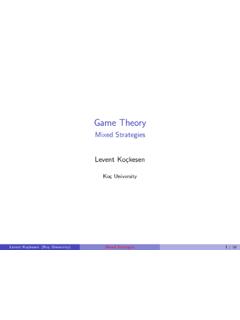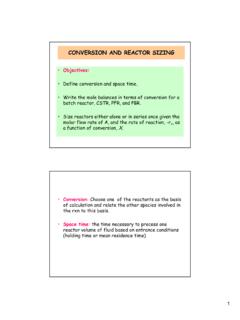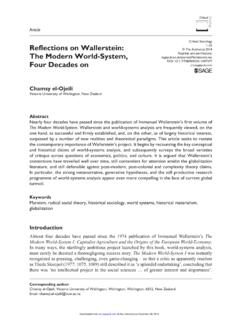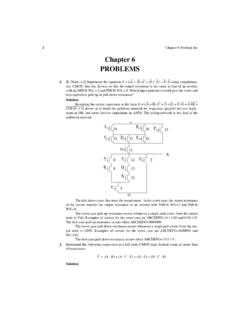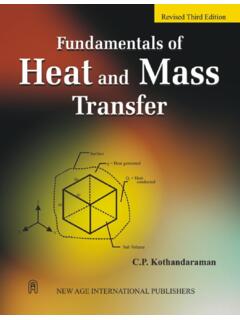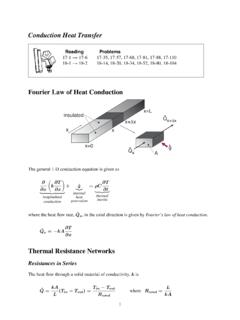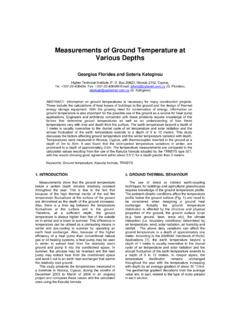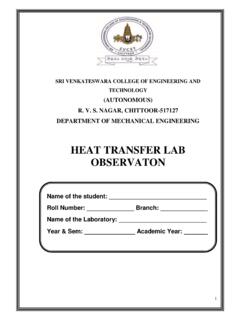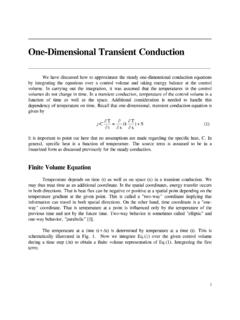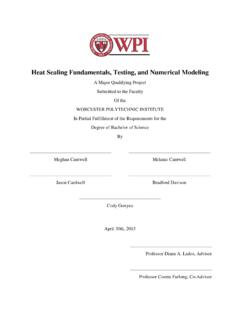Transcription of Mech 302 Heat Transfer HW5 Solution - #hayalinikeşfet
1 Mech 302 heat Transfer HW5 Solution 1. (Problem in the Book except for part (e)) For each of the following cases, determine an appropriate characteristic length Lc and the corresponding Biot number Bi that is associated with the transient thermal response of the solid object. State whether the lumped capacitance approximation is valid. If the temperature information is not provided, evaluate properties at T = 300 K. a. A toroidal shape of diameter D = 65 mm and cross-sectional area = 7 2 is of thermal conductivity k = W/mK. The surface of the torus is exposed to a coolant corresponding to a convection coefficient of h = 50 W/m2K. b. A long, hot AISI 302 stainless steel bar of rectangular cross-section has dimensions w = 5 mm, W = 7 mm, and L = 150 mm.
2 The bar is subjected to a coolant that provides a heat Transfer coefficient of h = 10 W/m2K at all exposed surfaces. c. A long extruded aluminum (Alloy 2024) tube of diameter of inner and outer dimensions w = 25 mm and W = 30 mm, respectively, is suddenly submerged in water, resulting in a convection coefficient of h = 40 W/m2K at the four exterior tube surfaces. The tube is plugged at both ends, trapping stagnant air inside the tube. d. An L = 300-mm-long solid stainless steel rod of diameter D = 13 mm and mass M = kg is exposed to a convection coefficient of h = 30 W/m2K. f. A long cylindrical rod of diameter D = 20 mm, density, specific heat cp = 1750 J/kgK, and thermal conductivity k = 16 W/mK is suddenly exposed to convective conditions with.
3 The rod is initially at a uniform temperature of T = 100 C at t = 225 s. g. Repeat part (f) but now consider a rod diameter of D = 200 mm. KNOWN: Geometries of various objects. Material and/or properties. Cases (a) through (d): Convection heat Transfer coefficient between object and surrounding fluid. Case (e): Emissivity of sphere, initial temperature, and temperature of surroundings. Cases (f) and (g): Initial temperature, spatially averaged temperature at a later time, and surrounding fluid temperature. FIND: Characteristic length and Biot number. Validity of lumped capacitance approximation. SCHEMATIC: Case (a): D = 65 mm, Ac = 7 2, k = W/m K, h = 50 W/ 2 K. Case (b): W = 7 mm, w = 5 mm, L = 150 mm, h = 10 W/ , AISI 302 stainless steel.
4 Case (c): w = 25 mm, W = 30 mm, h = 40 W/ 2 K (L not specified), 2024 aluminum. Case (d): L = 300 mm, D = 13 mm, M = kg, h = 30 W/ 2 K. stainless steel. Cases (f, g): D = 20 mm or 200 mm, = 2300 kg/ 3, cp = 1750 J/kg K, k = 16 W/m K, T = 20 C, Ti =200 C, T = 100 C at t = 225 s. ASSUMPTIONS: (1) Constant properties PROPERTIES: Table , Stainless steel, AISI 302 (T = 300 K): k = W/m K. Aluminum 2024 (T = 300 K): k = 177 W/m K. ANALYSIS: Characteristic lengths can be calculated as Lc1 = V/As, or they can be taken conservatively as the dimension corresponding to the maximum spatial temperature difference, Lc2. The former definition is more convenient for complex geometries. The lumped capacitance approximation is valid for Bi = hLc/k < (a) The radius of the torus, ro, can be found from 2 Ac = 02.
5 The characteristic lengths are 2= Maximum center to surface distance = radius = / = 7 2/ = The corresponding Biot numbers are The lumped capacitance approximation is valid according to either definition. (b) For this complex shape, we will calculate only Lc1. Notice that the surface area of the ends has been included, and does have a small effect on the result mm versus mm if the ends are neglected. The corresponding Biot number is The lumped capacitance approximation is valid. Furthermore, since the Biot number is very small, the lumped capacitance approximation would certainly still be valid using a more conservative length estimate. (c) Again, we will only calculate Lc1. There will be very little heat Transfer to the stagnant air inside the tube, therefore in determining the surface area for convection heat Transfer , only the outer surface area should be included.
6 Thus, The corresponding Biot number is The lumped capacitance approximation is valid. Furthermore, since the Biot number is very small, the lumped capacitance approximation would certainly still be valid using a more conservative length estimate. (d) We are not told which type of stainless steel this is, but we are told its mass, from which we can find its density: This appears to be AISI 316 stainless steel, with a thermal conductivity of k = W/m K at T = 300 K. The characteristic lengths are 2=Maximum center to surface distance=D2= Notice that the surface area of the ends has been included in Lc1, and does have a small effect on the result. The corresponding Biot numbers are The lumped capacitance approximation is valid according to either definition.
7 (f) The characteristic lengths are 2=Maximum center to surface distance = D/2 = 10mm We are not told the convection heat Transfer coefficient, but we do know the fluid temperature and the temperature of the rod initially and at t = 225 s. If we assume that the lumped capacitance approximation is valid, we can determine the heat Transfer coefficient from Equation : The resulting Biot numbers are: The lumped capacitance approximation is valid according to either definition. This also means that it was appropriate to use the lumped capacitance approximation to calculate h. (g) With the diameter increased by a factor of ten, so are the characteristic lengths: 2=Maximum center to surface distance=D2=100mm Once again, we assume that the lumped capacitance approximation is valid to calculate the heat Transfer coefficient according to The resulting Biot numbers are: The lumped capacitance approximation is not valid according to either definition.
8 This means that the calculated value of h is incorrect; therefore the above values of the Biot number are incorrect. However, we can still conclude that the Bi number is too large for lumped capacitance to be valid by the following reasoning. If the lumped capacitance approximation were valid, then the calculated h would be correct, and its value would be small enough to result in Bi < Since the calculated Biot number does not satisfy the criterion to use the lumped capacitance approximation, the initial assumption that the lumped capacitance method is valid must have been false. 2. (Problem in the book) A plane wall of a furnace is fabricated from plain carbon steel (k = 60 W/mK, =7850kg/ 3, c = 430 J/kgK) and is of thickness L = 10 mm.
9 To protect it from the corrosive effects of the furnace combustion gases, one surface of the wall is coated with a thin ceramic film that, for a unit surface area, has a thermal resistance of , ,, = m2K/W. The opposite surface is well insulated from the surroundings. At furnace start-up the wall is at initial temperature of Ti = 300 K, and combustion gases at =1300 enter the furnace, providing a convection coefficient of h = 25 W/m2K at the ceramic film. Assuming the film to have negligible thermal capacitance, how long will it take for the inner surface of the steel to achieve a temperature of Ts,i = 1200 K? What is the temperature Ts,o of the exposed surface of the ceramic film at this time?
10 KNOWN: Thickness and properties of furnace wall. Thermal resistance of film on surface of wall exposed to furnace gases. Initial wall temperature. FIND: (a) Time required for surface of wall to reach a prescribed temperature, (b) Corresponding value of film surface temperature. SCHEMATIC: ASSUMPTIONS: (1) Constant properties, (2) Negligible film thermal capacitance, (3) Negligible radiation. PROPERTIES: Carbon steel (given): = 7850 kg/ 3, c = 430 J/kgK, k = 60 ANALYSIS: The overall coefficient for heat Transfer from the surface of the steel to the gas is Hence, And the lumped capacitance method can be used. (a) It follows that (b) Performing an energy balance at the outer surface (s,o), 3.



